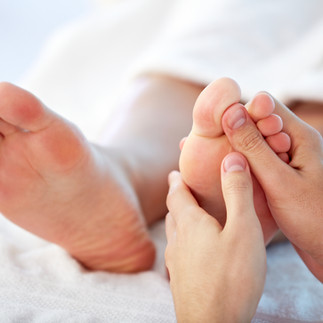Feet: An Osteopathic Perspective
Written by Osteopath Georgia Hutchinson.
Did you know osteopaths treat feet?
Feet are structures that are often under-appreciated until they start causing problems.
Your foot is made up of 26 bones, 33 joints and more than 100 muscles, tendons and ligaments! The foot's intricate network of structures work together to provide stability, flexibility, and propulsion during movement. From the heel bone to the multiple arches and the versatile toes, each component of the foot plays a unique role in supporting our body weight and facilitating movement.

When we are walking our ankle joints bear approximately 5 times our body weight and can bear up to 13 times more force during activities such as running. The feet act as shock absorbers, cushioning the impact of each step to protect the joints and soft tissues from excessive stress. Additionally, the feet contribute to balance and proprioception, allowing us to maintain stability by adjusting our body’s position. As the base foundation of our body, they endure extensive strain and pressure everyday. When we are standing, walking, running, or even sitting, our feet undergo stress.
The ankle and feet are multi-axial, meaning that they can move in multiple directions and perform many movements. This allows osteopaths to offer a holistic approach to assessing and treating foot-related issues. Osteopaths understand that foot pain or dysfunction may stem from imbalances elsewhere. Therefore, they conduct a thorough assessment to identify the root cause of the problem, rather than merely addressing the symptoms. Adequate foot function is essential not only for mobility but also for overall posture and musculoskeletal health.
Common problems associated with feet and ankles:
Ankle Sprain
Plantar Fasciitis
Bunion Pain
Achilles pain
Heel pain
Muscular Strains
Shin Splints
Tarsal Tunnel Syndrome
Stress fractures
Toe Pain
Osteopaths can employ a range of manual therapy techniques to address foot issues and restore optimal function. These may include soft tissue manipulation, joint mobilisation, muscle energy techniques, and myofascial release. Essentially, the goal is to improve the mobility of the joints, release tension in the muscles and fascia, and restore adequate alignment. Osteopathic treatment aims to alleviate pain, reduce inflammation, and enhance overall foot function.
Additionally, osteopaths may provide education and advice on footwear, ergonomics and exercise to support foot health and prevent the recurrence of problems. Custom orthotics, corrective exercises, and gait analysis may also be recommended to address underlying biomechanical issues and promote long-term wellness.
So there you have it! Feet; Strong, flexible and an important structure of the body. Influencing the way we walk, balance, run and jump. It’s super important to maintain your foot health.
Looking for support regarding a foot-related issue? Our osteopaths are here to help. Give us a call on 0425 876 929 or book below.
Resources:
Biomechanics of the ankle: 10.1016/j.mporth.2016.04.015
Foot and Ankle Structure and Function: https://www.physio-pedia.com/Foot_and_Ankle_Structure_and_Function









Comments